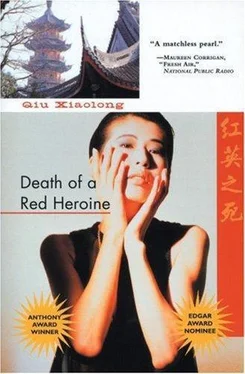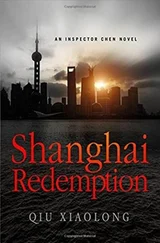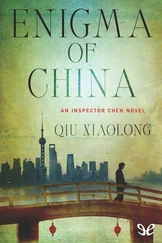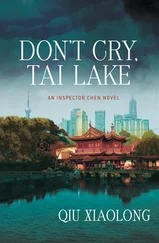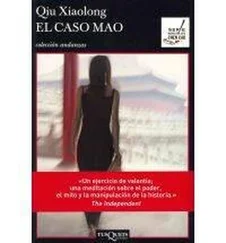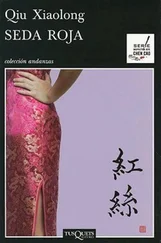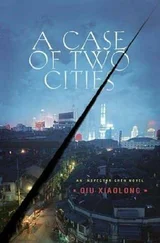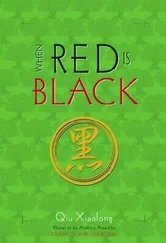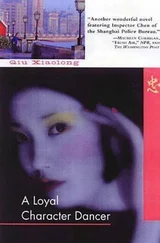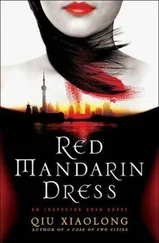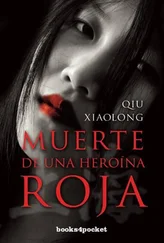Qiu Xiaolong - Death of a Red Heroine
Здесь есть возможность читать онлайн «Qiu Xiaolong - Death of a Red Heroine» весь текст электронной книги совершенно бесплатно (целиком полную версию без сокращений). В некоторых случаях можно слушать аудио, скачать через торрент в формате fb2 и присутствует краткое содержание. Жанр: Полицейский детектив, на английском языке. Описание произведения, (предисловие) а так же отзывы посетителей доступны на портале библиотеки ЛибКат.
- Название:Death of a Red Heroine
- Автор:
- Жанр:
- Год:неизвестен
- ISBN:нет данных
- Рейтинг книги:3 / 5. Голосов: 1
-
Избранное:Добавить в избранное
- Отзывы:
-
Ваша оценка:
- 60
- 1
- 2
- 3
- 4
- 5
Death of a Red Heroine: краткое содержание, описание и аннотация
Предлагаем к чтению аннотацию, описание, краткое содержание или предисловие (зависит от того, что написал сам автор книги «Death of a Red Heroine»). Если вы не нашли необходимую информацию о книге — напишите в комментариях, мы постараемся отыскать её.
Death of a Red Heroine — читать онлайн бесплатно полную книгу (весь текст) целиком
Ниже представлен текст книги, разбитый по страницам. Система сохранения места последней прочитанной страницы, позволяет с удобством читать онлайн бесплатно книгу «Death of a Red Heroine», без необходимости каждый раз заново искать на чём Вы остановились. Поставьте закладку, и сможете в любой момент перейти на страницу, на которой закончили чтение.
Интервал:
Закладка:
In the wastebasket, he saw nothing but several balls of tissues. On top of the chest was a bottle of vitamin pills, the cap still unbroken. Several lipsticks. Bottles of imported perfumes. A tiny plastic-framed mirror. He checked the drawers of the chest. The top drawer contained cash receipts from stores, some blank envelopes, and a movie magazine. The second drawer held several photo albums. The contents of the third was more mixed. An imitation leather trinket box holding an assortment of costume jewelry. Some more expensive lotions and perfumes, perhaps samples from the store. He also found a gold choker with a crescent-shaped pendant, a Citizen watch with clear stones around the face, and a necklace made of some exotic animal bone.
In the cupboard fastened on the wall, he saw several glasses and mugs, but only a couple of black bowls with a small bunch of bamboo chopsticks. It was understandable, Chen reflected. It was not a place to which to invite people. She could have offered a cup of tea at the most.
He opened one door of the wardrobe, which revealed several shelves of tightly packed clothes: a dark-brown winter overcoat, several white blouses, wool sweaters, and three pairs of trousers hung in a corner, all of them demure and rather dull in color. They were not necessarily inexpensive but seemed conservative for a young woman. On the floor stood a pair of high-heeled black shoes, a pair of oxfords with rubber spikes, and a pair of galoshes.
When he opened the other door, however, it revealed a surprise. On the top shelf lay some new, well-made clothes, of fine material and popular design. Chief Inspector Chen did not know much about the fashion world, but he knew they were expensive from the well-known brands or the shop tags still attached to them. Underneath was a large collection of underwear that women’s magazines would probably term “romantic,” or even “erotic,” some of the sexiest pieces he had ever seen, with the lace being a main ingredient rather than a trimming.
He was unable to reconcile the striking contrast between the two sides of the wardrobe.
She had been a single woman, not dating anyone at the time of her death.
Then he moved back to the chest, took the photo albums out of the drawer, and put them on the table, next to a tall glass of water containing a bouquet of wilted flowers, a pen holder, a small paper bag of black pepper, and a bottle of Crystal pure water. It seemed that the table had served as her dining table, desk, and kitchen counter-all in one.
There were four albums. In the first, most of the pictures were black-and-white. A few showed a chubby girl with a ponytail. A girl of seven or eight, grinning for the camera, or blowing out candles on a cake. In one, she stood between a man and woman on the Bund, the man’s image blurred but the woman’s fairly clear. Presumably her parents. It took four or five album pages for her to start wearing a Red Scarf-a Young Pioneer saluting the raising of the five-starred flag at her school. The pictures were arranged chronologically.
He snapped to attention when he turned to a small picture on the first page of the second album. It must have been taken in the early seventies. Sitting on a rock by a pool, one bare foot dabbling in the water, the other held up above the knee, Guan was piercing the blisters on her sole with a needle. The background showed several young people holding a banner with the words LONGMARCH on it, striding proudly toward the Yan’an pagoda in the distance. It was the da chuanlian period of the Cultural Revolution when Red Guards traveled all around the country, spreading Chairman Mao’s ideas on “continuation of the revolution under the proletarian dictatorship.” Yan’an, a county where Mao had stayed before 1949, became a sacred place, to which Red Guards made their pilgrimage. She must have been a kid, newly qualified as a Red Guard, but there she was, wearing a red armband, blistered, but eager to catch up.
In the middle of the second album, she had grown into a young girl with a fine, handsome face, big almond eyes, and thick eyelashes. There was more resemblance to National Model Worker Guan as shown in the newspapers.
The third album consisted of pictures from Guan’s political life. There were a considerable number of them showing her together with various Party leaders at one conference or another. Ironically, these pictures could have served to trace the dramatic changes in China’s politics, with some leaders vanishing, and some moving to the front, but Guan, unchanged, stood in her familiar pose, in the familiar limelight.
Then came the last album, the thickest: the pictures of Guan’s personal life. There were so many of them, and they were all so different, Chen was impressed. Shots from various angles, in various outfits, and with various backgrounds: reclining in a canoe at dusk, wearing a striped camp shirt with a fitted skirt, her face calm and relaxed; standing on her toes by an imported limousine in sunlight; kneeling on the muddy plank of a little bridge, scratching her bare ankle, bending forward over the railing, the weight of her body resting on her right foot; gazing at the misty horizon through a window, her face framed by her tangled hair, a cloud of velvety cattail blurred in a distant field; perching on the steps of an ancient temple, a transparent plastic raincoat over her shoulders, a silk scarf drawn over her hair, her mouth half-open, as if she were on the verge of saying something…
It was not just that the pictures formed a sharp contrast to her “model worker” image in the previous album. In these pictures, she struck Chief Inspector Chen as more than pretty or vivacious. She looked radiant, lit from within. It seemed there was a message in these pictures. What it was, however, Chen could not decipher.
There were also a couple of more surprising close-ups: in one, she was lying on a love seat, her round shoulders covered only with a white bath towel; in another, she was sitting on a marble table, wearing a terry robe, dangling her bare legs; in yet another, she was kneeling, in a bathing suit, its shoulder straps off, her hair tousled, looking breathless.
Chief Inspector Chen blinked, trying to break the momentary spell of Guan’s image.
Who had taken these pictures, he wondered. Where had she had them developed? Especially the close-ups. State-run studios would have refused to take the order, for some of the pictures could be labeled as “bourgeois decadent.” And at unscrupulous private studios, she might have run a serious risk, for those entrepreneurs could have sold such pictures for money. It could have been politically disastrous if she had been recognized as the national model worker.
An album page was large enough for four standard-sized pictures, but for several pages, each held only one or two. The last few pages were blank.
It was about noon when he returned the albums to the drawer. He did not feel hungry. Through the window he thought he could hear the distant roar of a bulldozer working at a construction site.
Chief Inspector Chen decided to talk to Guan’s neighbors. He first went to the next door along the corridor, a door still decorated with a faded red paper couplet celebrating the Chinese Spring Festival. There was also a plastic yin-yang symbol dangling as a sort of decoration.
The woman who opened the door was small and fair, wearing slacks and a cotton-knit top, a white apron around her waist. She must have been busy cooking, for she wiped one hand on the apron as she held the door open with the other. He guessed she was in her mid-thirties. She had tiny lines around her mouth.
Chen introduced himself, showing his business card to her.
“Come in,” she said, “my name is Yuan Peiyu.”
Another efficiency room. Identical in size and shape to Guan’s, it appeared smaller, with clothes and other diverse objects scattered round. In the middle of the room was a round table bearing row upon row of fresh-made dumplings, together with a pile of dumpling skins and a bowl of pork stuffing. A boy in an imitation army uniform came out from under the table. He was chewing a half-eaten bun, staring up at Chen. The little soldier stretched up a sticky fist and made a gesture of throwing the bun toward Chen like a grenade.
Читать дальшеИнтервал:
Закладка:
Похожие книги на «Death of a Red Heroine»
Представляем Вашему вниманию похожие книги на «Death of a Red Heroine» списком для выбора. Мы отобрали схожую по названию и смыслу литературу в надежде предоставить читателям больше вариантов отыскать новые, интересные, ещё непрочитанные произведения.
Обсуждение, отзывы о книге «Death of a Red Heroine» и просто собственные мнения читателей. Оставьте ваши комментарии, напишите, что Вы думаете о произведении, его смысле или главных героях. Укажите что конкретно понравилось, а что нет, и почему Вы так считаете.
